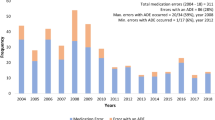Abstract
Background
Patient-controlled analgesia (PCA) is a common and effective means of managing post-operative pain. We sought to identify factors that may lead to critical incidents (CIs) in patient safety when using PCA in our institution.
Methods
An observational study of prospectively collected data of patients who received PCA from 2002 to 2006 was performed. All CIs were documented and analysed by staff members of the acute pain service (APS). Cause analysis of CIs was undertaken to determine if measures can be instituted to prevent recurrence of similar events.
Results
Over eight thousand patients (8,240) received PCA. Twenty-seven CIs were identified. Eighteen were due to programming errors. Other CIs included co-administration of opioids and oversedation.
Conclusion
In our institution, the largest contributory factor to CIs with PCAs was programming error. Strategies to minimize this problem include better education and surveillance.
Similar content being viewed by others
References
Hudcova J, McNicol E, Quah C et al (2006) Patient controlled opioid analgesia versus conventional opioid analgesia for postoperative pain. Cochrane Database Syst Rev 4:CD003348 (18 October)
Sechzer PH (1968) Objective measurement of pain. Anesthesiology 29:209–210
Sechzer PH (1971) Studies in pain with analgesic-demand system. Anesth Analg 50:1–10
Khan FA, Khimani S (2007) Customer focused incident monitoring in anaesthesia. Anaesthesia 62(6):586–590
Dave M et al (2003) Quality assurance in prescribing of patient-controlled analgesia and long acting opiods. Am J Health Syst Pharm 60(14)
Chen PP et al (1998) Incident reporting in acute pain management. Anaesthesia 53:730–735
Anderson B, Nilsson S (1964) Studies in the reliability and validity of critical incident technique. J Appl Psychol 48:398–403
Webb RK, Currie M, Morgan CA et al (1993) The Australian Incident Monitoring Study: an analysis of 2000 incident reports. Anaesth Intensive Care 21:520–528
Buckley TA, Short TG, Rowbottom YM et al (1997) Critical incident reporting in intensive care unit. Anaesthesia 52:403–409
Tsui SL, Tong WN, Irwin M et al (1996) The efficacy, applicability and side-effects of postoperative intravenous patient-controlled morphine analgesia: an audit of 1233 Chinese patients. Anaesth Intensive Care 24:658–664
Macintyre PE (2001) Safety and efficacy of patient-controlled analgesia. Br J Anaesth 87:36–46
Popping DM, Zahn PK, Van Aken HK et al (2008) Effectiveness and safety of postoperative pain management: a survey of 18925 consecutive patients between 1998 and 2006; a database of prospectively raised data. Br J Anaesth 101960:832–840
Cheung CW, Ying CL, Lee LH et al (2009) An audit of postoperative intravenous patient-controlled analgesia with morphine: evolution over the last decade. Eur J Pain 13(5):464–471
Shapiro A, Zohar E, Kantor M et al (2004) Establishing a nurse-based, anesthesiologist-supervised inpatient acute pain service: experience of 4,617 patients. Clin Anesth 16(6):415–420
Hung CT, Lau LL, Chan CK et al (2002) Acute pain services in Hong Kong: facilities, volume, and quality. Hong Kong Med J 8(3):196–201
Lin L, Isla R, Doniz K et al (1998) Applying human factors to the design of medical equipment: patient-controlled analgesia. Clin Monit Comput 14(4):253–263
ECRI (2006) Patient-controlled analgesic infusion pumps. Health Devices 35(1):5–35
Cohen MR, Smetzer J (2005) Patient-controlled analgesia safety issues. J Pain Palliat Care Pharmacother 19(1):45–50
Institute for Safe Medication Practices (2004) Misprogramming a PCA Pump? It’s Easy! ISMP safety alert, 29 July. Available at http://www.ismp.org/Newsletters/acutecare/articles/20040729_2.asp. Accessed 1 August 2007
Institute for Safe Medication Practices (2003) Safety issues with patient controlled analgesia part 1—how errors occur. ISMP safety alert, 10 July. Available at http://www.ismp.org/Newsletters/acutecare/articles/20030710.asp. Accessed 1 August 2007
Grissinger M (2008) Safety and patient-controlled analgesia: part 2: how to prevent errors. Pharm Ther 33(1):8–9
Hicks RW, Sikirica V, Nelson W et al (2008) Medication errors involving patient controlled analgesia. Am J Health Syst Pharm 65(5):429–440
Hankin CS, Shein J, Clark JA et al (2007) Adverse events involving intravenous patient controlled analgesia. Am J Health Syst Pharm 64(14):1492–1499
Vincent KJ et al (2003) Programming errors contribute to death from patient-controlled analgesia: case report and estimate of probability. Can J Anesth 50(4):328–332
Looi-Lyons LC, Chung FF, Chun VW et al (1996) Respiratory depression: an adverse outcome during patient controlled analgesia therapy. J Clin Anesth 8(2):151–156
Ashburn MA, Love G, Pace NL (1994) Respiratory-related critical events with intravenous patient-controlled analgesia. Clin J Pain 10(1):52–56
Syed S, Paul JE, Hueftlein M et al (2006) Morphine overdose from error propagation on an acute pain service. Can J Anesth 53(6):586–590
Grissinger M (2008) Misprogram a PCA pump? It’s easy. PT 33(10):567–568
Chen HH, Yeh ML, Yang HJ (2005) Testing the impact of multimedia CD of PCA on pain knowledge and pain relief in patients receiving surgery. Int J Med Inform 74(6):437–445
Yeh ML, Chen HH, Liu PH (2005) Effects of multimedia with printed nursing guides in education on self efficacy and functional activity and hospitalization in patients with hip replacement. Patient Educ Couns 57(2):217–224
Conflict of interest statement
None.
Author information
Authors and Affiliations
Corresponding author
Rights and permissions
About this article
Cite this article
Ahmad, I., Thompson, A., Frawley, M. et al. Five-year experience of critical incidents associated with patient-controlled analgesia in an Irish University Hospital. Ir J Med Sci 179, 393–397 (2010). https://doi.org/10.1007/s11845-010-0482-6
Received:
Accepted:
Published:
Issue Date:
DOI: https://doi.org/10.1007/s11845-010-0482-6




